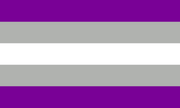The asexual spectrum, abbreviated as acespec[1] or ace-spec[2], refers to sexual orientations that are asexual or are closely related to asexuality. Identities under the asexual umbrella are closely connected as part of a broad community.[2][3][4]
| Stub | |
| This article is a stub. You can help LGBTQIA+ Wiki by expanding it. |
Community[]
Identities under the umbrella[]
The identities below are listed alphabetically, following asexual itself.
Asexual[]
- Main article: Asexual

The asexual pride flag
Asexual refers to people who do not experience sexual attraction toward others,[3] as well as people who experience limited or conditional sexual attraction[5] and relate to the label asexual more than other sexual identity terms.[3] They may experience other forms of attraction, such as romantic, sensual, or aesthetic attraction. Asexuality is a sexual orientation,[6] not a behavior, choice, or medical condition. Some asexual people choose to engage in sexual activities for various reasons despite not experiencing sexual feelings and desire toward any particular person.[3][5] Asexuality is part of the asexual spectrum (abbreviated "ace spectrum"), an umbrella term and a broad community of identities that are closely related to asexuality when placed on a spectrum ranging from asexual to allosexual.[3]
Aceflux[]

The aceflux pride flag
Aceflux has two common definitions:[7]
- Someone with a fluctuating orientation, and that orientation is always within the asexual spectrum.[2][4][7]
- Someone with an orientation that fluctuates between no attraction, some attraction, and a lot of attraction.[7]
Aegosexual[]

The aegosexual pride flag
Aegosexual, also known less commonly as anegosexual[8] and formerly referred to as autochorissexual ("autochoris" means "identity-less"), is a microlabel on the asexual spectrum that describes those who experience a disconnect between themselves and the subject of arousal. The contemporary term is made up of the prefix "a/an-" meaning 'not', "ego" for 'self', and 'sexual'. Hence, "aegosexual" or "anegosexual" literally means "sexual without self". Aegosexuals may have sexual fantasies, view sexual content, or masturbate, but typically feel little to no sexual attraction or desire to engage in sexual intercourse. Many aegosexuals fantasize about sex from a third-person perspective.[2][4][9][10]
Apothisexual[]

The apothisexual flag
Apothisexual, which stems from the Greek root "apothisan" meaning 'repulsed', refers to someone who identifies as asexual and finds sex and/or sexual activity to be disgusting or uncomfortable. Individuals who use this term are affected by sex in the media to varying degrees, and may try to avoid its presence altogether. This term should not be confused with 'sex-negative', which means finding sex immoral.[4][11][12]
Autosexual[]
Autosexual or egosexual is a label that refers to someone who mostly or only feels sexual attraction to themselves.[4][13]
Cupiosexual[]

Cupiosexual flag
Cupiosexual, derived from "cupio" meaning longing, refers to a person who is asexual or on the asexual spectrum and still desires sexual actions despite not feeling an attraction towards people who'd inspire that desire.[2][4][14] The term originally showed up on forums in 2014. Although cupiosexuals will not experience sexual attraction to their sexual partner, there are a myriad of other reasons a cupiosexual may have sex, such as physical pleasure or a way to bond with one's partner.[15]
Demisexual[]
- Main article: Demisexual

The demisexual flag
Demisexual is a term used to describe those who do not experience sexual attraction to others unless they form a strong emotional bond with someone first. Demisexual people may still experience romantic attraction, but until a deep connection is formed, there is no sexual attraction involved. They may have little to no interest in sex and may only experience sexual attraction rarely, but that is not the case with all demisexuals.[16]
Another definition is a person who does not experience primary sexual attraction, defined as sexual attraction that is based on sight, smell, or other instantly available information. In this definition, demisexuals experience secondary sexual attraction after knowing more about the person than just their looks; how much demisexuals need to know about said person and for how long they need to know about them for secondary sexual attraction to develop varies from person to person.[17] After secondary sexual attraction is developed, demisexuals may or may not experience arousal or desire based on the physical traits of the persons they already experience secondary sexual attraction towards; usually they are not only aroused by personality traits.[18][19]
Demisexuality is included on the asexual spectrum, but demisexual people can be gay, straight, bisexual, or any other orientation in addition to being demisexual.[20]
Fraysexual[]

The fraysexual pride flag
Fraysexual or ignotasexual describe individuals who experience sexual attraction to those whom they do not know very well. For some fraysexual people, they may initially be attracted to another person; however, they find that their sexual attraction fades over time, particularly as an emotional connection is formed.[2][4][21][22] Some fraysexual people have described their sexuality as an "imbalance of morals" that prevents them from being able to engage in sexual acts with any other person close to them.[23][24] Fraysexuality has been considered by some to be the "opposite" of demisexuality.[25]
Gray-asexual[]
- Main article: Gray-asexual

The gray-asexual flag
Gray-asexual,[26] also known as graysexual or gray-A,[26][27][28][29] is an asexual identity characterized as being "in between" asexual and allosexual; that is, being asexual while also able to experience, or have experienced previously, sexual attraction.[26] People who identify as gray-asexual may experience sexual attraction that is uncommon for the individual, may only be directed toward specific people,[30] occurs infrequently, at low intensity, or in an ambiguous way.[7][31] The term is often included in the asexual spectrum.[32]
Lithosexual[]
Lithosexual, formerly known as "akoisexual", is a term for someone who feels sexual attraction only for those that do not reciprocate those feelings.[2][4][33]
Flag[]

The asexual spectrum pride flag
While the overall asexual flag is often used to represent the asexual spectrum, there is also a flag design specifically made to represent this spectrum.[4][34] This design was posted to Tumblr on July 25, 2020, by Potion of the Flag Archive blog. It has four equal-sized horizontal stripes, and they suggested the following meanings for the colors: dark blue for community, its history, and solidarity; purple for asexuality in all variations and personal labels, pink for self-determination, pride, and acceptance; cream for diversity in experiences and types of attraction.[35]
